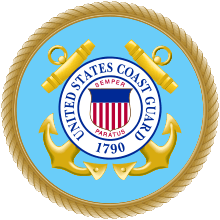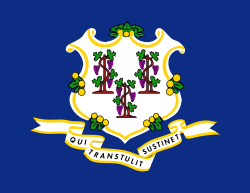United States Coast Guard Academy
The United States Coast Guard Academy (USCGA) is the service academy of the United States Coast Guard in New London, Connecticut. Founded in 1876, it is the smallest of the five U.S. service academies and provides education to future Coast Guard officers in one of nine major fields of study. Unlike the other service academies, the Coast Guard Academy does not require a congressional nomination for admission.
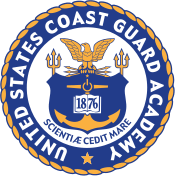 | |
Former names | Revenue Cutter Service School of Instruction (1876-1914) Revenue Cutter Academy (1914-1915) |
|---|---|
| Motto | Scientiæ Cedit Mare (Latin) |
Motto in English | The sea yields to knowledge |
| Type | U.S. Service Academy |
| Established | 1876 |
Academic affiliations | NEASC, ABET, AACSB[1]· |
| Superintendent | RADM William G. Kelly |
| Dean | CAPT Kurt J. Colella USCG, ret. |
| Commandant | CAPT Richard J. Wester |
Academic staff | 130 |
| Students | 1,045 cadets[2] |
| Location | 31 Mohegan Avenue New London , , United States 41°22′22″N 72°06′06″W |
| Campus | Suburban – 110 acres (44.5 ha) |
| Fight song | "Semper Paratus" |
| Colors | Blue and Orange |
| Nickname | Bears |
Sporting affiliations | NCAA Division III – NEWMAC |
| Mascot | Objee the Bear |
| Website | www |
Students are officers-in-training and are referred to as cadets, and upon graduation receive a Bachelor of Science degree and are commissioned as Coast Guard ensigns with a five-year active-duty service obligation,[3] with additional years if the graduate attends flight school or subsequent government-funded graduate school. Out of approximately 250 cadets entering the academy each summer, around 200 graduate. Cadets can choose from among nine majors, with a curriculum that is graded according their performance in a holistic program of academics, physical fitness, character, and leadership.
Cadets are required to adhere to the academy's "Honor Concept," "Who lives here reveres honor, honors duty," which is emblazoned in the halls of the academy's entrance. The academy's motto is Scientiæ cedit mare, which is Latin for "the sea yields to knowledge".
The academy is accredited by the New England Association of Schools and Colleges, ABET, and AACSB for its various programs.[4]
History
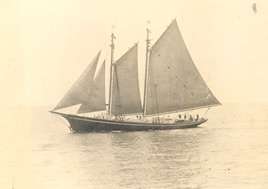
The roots of the academy lie in the School of Instruction of the Revenue Cutter Service, the school of the Revenue Cutter Service. The School of Instruction was established near New Bedford, Massachusetts in 1876 and used USRC Dobbin for its exercises. Captain John Henriques served as superintendent from founding until 1883. The one civilian instructor was Professor Edwin Emery, who taught mathematics, astronomy, English composition, French, physics, theoretical steam engineering, history, international law, and revenue law, among other subjects.[5] The school was a two-year apprenticeship, in essence, supplemented by minimal classroom work. The student body averaged five to ten cadets per class. With changes to new training vessels, the school moved to Curtis Bay, Maryland in 1900 and to Fort Trumbull in 1910, a Revolutionary War–era Army installation in New London, Connecticut. In 1914, the school became the Revenue Cutter Academy, and it became the Coast Guard Academy in 1915 with the merger of the Revenue Cutter Service and the Life Saving Service.
Land was purchased in New London on 31 July 1930 for the construction of the Coast Guard Academy. The 40-acre site was made up of two parcels from the Allyn and Payne estates and was purchased for $100,000. The $100,000 was not raised through a bond issue, as originally planned, but with a bank loan based on uncollected back taxes.[6] The contract was awarded to Murch Brothers Construction Company of St. Louis and ground was broken on January 1931 by Jean Hamlet, daughter of Rear Admiral Harry G. Hamlet, Academy Superintendent from 1928–1932. On 15 May 1931, Treasury Secretary Andrew W. Mellon visited New London to lay the cornerstone of Hamilton Hall. Construction proceeded relatively on schedule and cadets moved in to the new buildings on 20 September 1932.[6]
In 1946, the academy received the barque Horst Wessel as a war reparation from Germany, a 295-foot tall ship which was renamed USCGC Eagle. It remains the main training vessel for cadets at the academy as well as for officer candidates at the Coast Guard's Officer Candidate School, which is located on the grounds of the academy.
The academy was racially integrated in 1962 at the request of President Kennedy.[7] The academy began admitting women in 1976 at the request of Congress.[8]
Mission
Superintendent of the academy Vice Admiral Harry G. Hamlet composed the academy's mission statement in 1929. All entering cadets must memorize the statement during their first few days of Swab Summer, the indoctrination period for new cadets.
The mission of the United States Coast Guard Academy is to graduate young men and women with sound bodies, stout hearts and alert minds, with a liking for the sea and its lore, and with that high sense of Honor, Loyalty and Obedience which goes with trained initiative and leadership; well-grounded in seamanship, the sciences and the amenities, and strong in the resolve to be worthy of the traditions of commissioned officers in the United States Coast Guard, in the service of their country and humanity.[9]
Admission
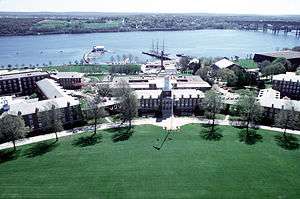
Unlike the other service academies, admission to the USCGA does not require a congressional nomination. This is due to the fervent objections of Captain John A. Henriques, the first Superintendent of the Revenue Cutter School of Instruction (later the Revenue Cutter Academy). His objection stemmed from years of poor political appointments in the U.S. Revenue Cutter Service's bureaucracy.
Each year more than 2,000 students apply and appointments are offered until the number accepting appointments to the incoming class numbers reaches approximately 400; the average entering class size is 300 cadets.[10] Those who have received appointments as cadets report to the USCGA in late June or early July for "Swab Summer", a basic military training program designed to prepare them for the rigors of their Fourth Class year. After four years of study and training, approximately 200 of those cadets will graduate. About 35 percent of cadets are women.
Academics
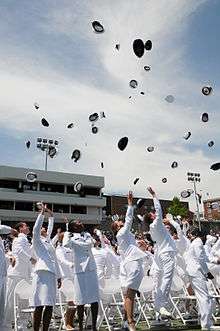
All graduating cadets earn commissions as ensigns in the United States Coast Guard, as well as Bachelor of Science degrees. For that reason the academy maintains a core curriculum of science and professional development courses in addition to major-specific courses. Each cadet takes two semesters of classes during the school year and then spends the majority of the summer in military training to produce officers of character with the requisite professional skills. Among these are courses in leadership, ethics, organizational behavior, and nautical science. The majority of cadets report to their first units after graduating, which are either afloat units, shore units, or basic flight training as student naval aviators, with the training conducted under the auspices of the U.S. Navy. Those that are assigned afloat serve as either deck watch officers or student engineers. Professional maritime studies courses help prepare cadets in piloting, voyage planning, deck seamanship, and all aspects of shiphandling, as well as Coast Guard leadership and administrative duties.
Majors
Academics at the USCGA stress the sciences and engineering, but different courses of study are available. In addition, several of the majors offer tracks of specialization (for example, Marine and Environmental Science majors can choose to focus on biology, chemistry, or geophysics). Cadets sometimes opt to take elective courses with Connecticut College (adjacent the academy's campus) as part of an open exchange agreement.
Military training
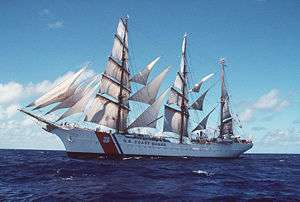
Each summer, cadets participate in training programs according to their class. The summers are organized as follows:[11]
- Swab Summer: The new class of freshmen report in to the Academy, and are sworn into the military. They undergo a seven-week basic training program that culminates on a week-long voyage underway on the barque USCGC Eagle.
- Third-class (3/c) Summer: Five weeks aboard the USCGC Eagle training under sail, five weeks aboard an operational Coast Guard cutter or small boat station in the role of junior enlisted (i.e., standing watches as helmsman, lookout, quartermaster of the watch, or engineering watch).
- Second-class (2/c) Summer: Damage control training, weapon qualifications, navigation rules certification, aviation internship, sail training program, and three weeks as members of the cadre, who train the incoming Swabs.
- First-class (1/c) Summer: Ten weeks aboard an operational cutter in the role of a junior officer (i.e., standing bridge watches conning the ship as Officer of the Deck), or an optional internship for exceptional cadets who split their summer with five weeks at an internship and five weeks aboard a cutter.
Each week during the school year cadets participate in Regimental Review, a formal military drill. In addition, cadets perform a variety of military duties at the academy. Like all cadets and midshipmen at the United States service academies, Coast Guard cadets are on active duty in the military and wear uniforms at all times. Cadets receive a monthly stipend to pay for books, uniforms, and other necessities. Cadets receive monthly pay of $1,017.00, as of 2015.[12] From this amount, pay is automatically deducted for the cost of uniforms, books, supplies, services, and other miscellaneous expenses.
Organization of the Corps of Cadets
The Corps is organized as one regiment divided into eight companies, each of which is composed of about 120 cadets of all classes. Although the Corps of Cadets is supervised directly by the Commandant of Cadets (a Coast Guard officer with the rank of captain), the academy operates on the concept of "the Corps leading the Corps."
The Corps of Cadets is largely a self-directed organization that follows a standard military chain of command:[13]
- 1st class cadets lead the Corps
- 2nd class cadets are cadre in Swab Summer training and are primarily responsible for leading and developing 4th class cadets. They serve as mentors
- 3rd class cadets are role models to 4th class cadets
- 4th class cadets are responsible for learning and applying Coast Guard core values such as leadership, teamwork, attention to detail, accountability, etc.
The highest-ranking cadet in each company is the Company Commander, a first-class cadet ("firstie"), equivalent to a senior. Although each company has some leeway in their standards and practices, every company commander reports to the Regimental Staff who plan and oversee all aspects of cadet life. At the top of the cadet chain of command is the Regimental Commander, the highest ranking cadet. Command positions, both in companies and on Regimental Staff, are highly competitive, and a cadet's overall class rank is often a deciding factor in who is awarded the position.
The eight companies are named for the first eight letters of the NATO phonetic alphabet. Each has a special focus in administering day-to-day affairs: Alpha company manages health and wellness. Bravo Company runs training. Charlie company administers the honor system, Delta Company coordinates drill and ceremonies. Echo Company manages transportation and logistics. Foxtrot operate the cadet conduct system, organizes the watch rotations, and updates the cadet regulations. Golf Company is in charge of supplies for cleaning and repairing damaged rooms within Chase Hall. Hotel company is in charge of morale events. To accomplish these missions, each company is divided, along shipboard lines, into three departments, each of which is divided into divisions with specific responsibilities. Divisions are the most basic unit at the Coast Guard Academy, and each has a very specific purpose. Each division is led by a firstie and contains several members of each other class.
This organizational structure is designed to give every cadet a position of leadership and to emulate the structure of a Coast Guard cutter, in which the division officer and department head positions are filled by junior officers. Third-class cadets directly mentor the fourth-class in their division, just as junior petty officers would be responsible for the most junior enlisted personnel (non-rates). Second-class cadets act as non-commissioned officers, and ensure that the regulations and accountability are upheld. Firsties (like junior officers) are in supervisory roles, and are responsible for carrying out the mission of their divisions and ensuring the well-being of those under their command. Exchange cadets from the other federal service academies are also a part of the Corps, and take part in many activities alongside their USCGA counterparts.[14]
Extracurricular activities
Athletics
The USCGA Athletic Department offers 24 intercollegiate sports for cadets. The academy's athletics teams generally compete in Division III of the National Collegiate Athletic Association. Cadets devote two hours per academic day to athletic activities, either on varsity teams, club teams, or other sports pursuits. The academy nickname is the Bears, after the USRC Bear, which made a dramatic rescue in Alaska in 1897, shortly after the opening of the academy.
Music
Principal non-athletic activities are musical centered on Leamy Hall. Regimental Band, Windjammers Drum & Bugle Corps, various pep bands, and the NiteCaps Jazz Band are instrumental programs. Chapel Choirs, Glee Club, the Fairwinds all-female a cappella group, and The Idlers all-male sea shanty group are vocal programs.
Model UN
The academy's Model UN team was started in 2004, and has since been successfully competing around North America, and at the World Model UN Conference.
Traditions
Links in the Chain
For years it has been a United States Coast Guard Academy tradition for fourth-class cadets (freshman) to hide the chain links that sit outside the cadet library, also known as Waesche Hall. The chain links are historic: they were used during the Revolutionary War to prevent ships from transiting up the Hudson River and attacking West Point. When Benedict Arnold betrayed the United States, the chain links were one of the secrets that he revealed to the British. The family that originally forged the chain donated the links to the United States Coast Guard Academy. Since the donation, the fourth-classmen (freshmen) are challenged each year at the annual homecoming football game to outwit the second-classmen (juniors) and keep the chain hidden until half-time. If the fourth-classmen are successful in hiding the links until the end of the second quarter, they are granted a week of modified carry-on (this allows the fourth-classmen to have some of the privileges of the upperclassmen).
Indoc
As part of their indoctrination into military culture, and to condition them for the frenetic flow of information during a shipboard watch, 4/c cadets are forced to sharpen their attention to detail and to develop an ability to accurately recall seemingly trivial facts from short- and medium-term memory. The incoming class of cadets every year is required to memorize various quotes, Coast Guard facts, and bits of information that change during the year. They are responsible for knowing reams of information like the menu for the next three meals in the Wardroom (dining hall), the mission of the Academy, the entire chain of command, each athletic team's next scheduled opponent, the lengths of different types of Coast Guard Cutters, the meanings of all the different nautical flags, and the finer points of various military ceremonies.
Indoc during the Swab Summer training program also includes humorous questions that cement the identity of a class, such as "How's the cow?" A swab from the Class of 2022 would be required to reply, "Sir/Ma'am, she walks, she talks, she's full of chalk; the lacteal fluid extracted from the female of the bovine species is highly prolific to the 22nd degree, sir/ma'am!".
Notable alumni
Alumni of the Coast Guard Academy are known collectively as the "Long Blue Line".[15]
| Name | Class | Notability |
|---|---|---|
| Worth G. Ross | 1879 |
Captain-Commandant; 3rd Commandant of the Coast Guard (1905–1911), member of the first graduating class of the School of Instruction[16] |
| William E. Reynolds | 1880 |
Rear Admiral; 5th Commandant of the Coast Guard (1919–1924) |
| Ellsworth P. Bertholf | 1887 |
Commodore; last Captain-Commandant of the United States Revenue Cutter Service (1911–1915); 4th Commandant of the Coast Guard (1915–1919);[17] awarded Congressional Gold Medal for participation in the Overland Relief Expedition |
| Leonidas I. Robinson | 1889 |
First Academy graduate to die in the line of duty |
| Frederick C. Billard | 1896 |
Rear Admiral; 6th Commandant of the Coast Guard (1924–1932); Superintendent of the United States Coast Guard Academy (1921–1924) |
| Harry G. Hamlet | 1896 |
Vice Admiral; 7th Commandant of the Coast Guard (1932–1936); Superintendent of the United States Coast Guard Academy (1928–1932); Gold Lifesaving Medal recipient; author of the "Creed of the United States Coast Guardsman" |
| Russell R. Waesche | 1906 |
Admiral; 8th Commandant of the Coast Guard (1936–1946); longest serving Commandant |
| Philip F. Roach | 1907 |
Commodore; recipient of the Navy Cross[18] |
| William J. Keester | 1910 |
Rear Admiral; Commander of the 5th Coast Guard District |
| Joseph Stika | 1911 |
Vice Admiral; recipient of the Navy Cross[19] |
| Joseph F. Farley | 1912 |
Admiral; 9th Commandant of the Coast Guard (1946–1950) |
| Elmer Fowler Stone | 1913 |
United States Naval Aviator, piloted the NC-4 on the first naval transatlantic flight[20] |
| Lyndon Spencer | 1918 |
Vice Admiral; commanding officer of the USS Bayfield (APA-33) during World War II[21] |
| Harold G. Bradbury | 1920 |
Rear Admiral; commanding officer of the USS Leonard Wood (APA-12), USS Wakefield (AP-21) and USCGC Duane (WPG-33) during World War II; Commander of the 1st Coast Guard District[22] |
| Merlin O'Neill | 1921 |
Vice Admiral; 10th Commandant of the Coast Guard (1950–1954); 4th Vice Commandant of the Coast Guard (1946–1949) |
| Alfred C. Richmond | 1924 |
Admiral; 11th Commandant of the Coast Guard (1954–1962) |
| Edward Thiele | 1927 |
Rear Admiral; Engineer-in-Chief of the Coast Guard (1958–1961)[23] |
| Carl B. Olsen | 1928 |
Rear Admiral; Commander of the 8th Coast Guard District[24] |
| Edwin J. Roland | 1929 |
Admiral; 12th Commandant of the Coast Guard (1962–1966); 7th Vice Commandant of the Coast Guard (1962) |
| Allen Winbeck | 1929 |
Rear Admiral; Commander of the 13th and 12th Coast Guard Districts[25] |
| A. J. Carpenter | 1933 |
Rear Admiral; Commander of the 11th and 3rd Coast Guard Districts[26] |
| John Birdsell Oren | 1933 |
Rear Admiral; Chief of Engineering[27] |
| Willard J. Smith | 1933 |
Admiral; 13th Commandant of the Coast Guard (1966–1970) |
| Chester R. Bender | 1936 |
Admiral; 14th Commandant of the Coast Guard (1970–1974) |
| Arthur B. Engel | 1938 |
Rear Admiral; Superintendent of the Coast Guard Academy (1967–1970)[28] |
| Benjamin F. Engel | 1938 |
Vice Admiral; Commander of the 14th and 3rd Coast Guard Districts[29] |
| Thomas R. Sargent III | 1938 |
Vice Admiral; 11th Vice Commandant of the Coast Guard (1970–1974)[30] |
| Ellis L. Perry | 1941 |
Vice Admiral; 12th Vice Commandant of the Coast Guard (1974–1978)[31] |
| Owen W. Siler | 1943 |
Admiral; 15th Commandant of the Coast Guard (1974–1978) |
| G. William Miller | 1945 |
Chairman of the Federal Reserve (1978–1979); United States Secretary of the Treasury (1979–1981)[32] |
| John B. Hayes | 1947 |
Admiral; 16th Commandant of the Coast Guard (1978–1982)[33] |
| Robert A. Duin | 1948 |
Rear Admiral; Commander of the 17th Coast Guard District[34] |
| James S. Gracey | 1949 |
Admiral; 17th Commandant of the Coast Guard (1982–1986) |
| Sidney A. Wallace | 1949 |
Rear Admiral; Chief of Public and International Affairs (1975–1977)[35] |
| Benedict L. Stabile | 1950 |
Vice Admiral; 14th Vice Commandant of the Coast Guard |
| Paul A. Yost, Jr. | 1951 |
Admiral; 18th Commandant of the Coast Guard (1986–1990) |
| Robert S. Lucas | 1952 |
Rear Admiral; Commander of the 17th Coast Guard District[36] |
| James C. Irwin | 1953 |
Vice Admiral; 15th Vice Commandant of the Coast Guard |
| Theodore J. Wojnar | 1953 |
Rear Admiral; Commander of the 13th Coast Guard District[37] |
| William P. Kozlovsky | 1954 |
Rear Admiral; Commander of the 14th Coast Guard District[38] |
| Clyde T. Lusk | 1954 |
Vice Admiral; 16th Vice Commandant of the Coast Guard |
| J. William Kime | 1957 |
Admiral; 19th Commandant of the Coast Guard (1990–1994) |
| Robert T. Nelson | 1958 |
Vice Admiral; 18th Vice Commandant of the Coast Guard |
| William J. Ecker | 1960 |
Rear Admiral; Commander of the 2nd and 5th Coast Guard Districts[39] |
| Richard A. Appelbaum | 1961 |
Rear Admiral; Chief of Law Enforcement and Defense Operations[40] |
| Robert E. Kramek | 1961 |
Admiral; 20th Commandant of the Coast Guard (1994–1998) |
| Arthur E. Henn | 1962 |
Vice Admiral; 19th Vice Commandant of the Coast Guard |
| James C. Card | 1964 |
Vice Admiral; 21st Vice Commandant of the Coast Guard |
| Richard D. Herr | 1964 |
Vice Admiral; 20th Vice Commandant of the Coast Guard |
| James Loy | 1964 |
Admiral; 21st Commandant of the Coast Guard (1998–2002); Acting Secretary United States Department of Homeland Security(2005), United States Deputy Secretary of Homeland Security (2003–2005); 2nd Administrator of the Transportation Security Administration (2002–2003);[41] |
| Paul M. Blayney | 1965 |
Rear Admiral; Commander of the Thirteenth Coast Guard District[42] |
| Thomas H. Collins | 1968 |
Admiral; 22nd Commandant of the Coast Guard (2002–2006); guided the Coast Guard after the terrorist attacks of 9/11; 22nd Vice Commandant of the Coast Guard (2000–2002) |
| John T. Tozzi | 1968 |
Rear Admiral; Director of Information and Technology (1996–1997)[43] |
| Terry M. Cross | 1970 |
Vice Admiral; 24th Vice Commandant of the Coast Guard |
| Thad Allen | 1971 |
Admiral; Principal Federal Official for the response to Hurricane Katrina, Hurricane Rita and National Incident Commander for the response to the Deepwater Horizon oil spill in the Gulf Coast region; 23rd Commandant of the Coast Guard (2006–2010)[44] |
| Charles D. Wurster | 1971 |
Vice Admiral; national commodore of the Sea Scouting division of the Boy Scouts of America |
| Erroll M. Brown | 1972 |
Rear Admiral; First African-American Coast Guard flag officer[46] |
| Bruce E. Melnick | 1972 | |
| Timothy S. Sullivan | 1975 |
Rear Admiral; Senior Military Advisor and Operational Advisor to the United States Secretary of Homeland Security; Primary Military Coordinator between the United States Department of Homeland Security and United States Department of Defense[48] |
| Robert J. Papp, Jr. | 1975 |
Admiral; 24th Commandant of the Coast Guard (2010–2014)[49] |
| Paul A. Langlois | 1976 | Captain; Distinguished Flying Cross; USCGA Athletic Hall of Fame (2006); USCGA Hall of Heroes (2013); USCGA Distinguished Alumnus (2019)[50][51][52] |
| David Pekoske | 1977 | 7th Administrator of Transportation Security Administration (2017–Current);
Vice Admiral; 26th Vice Commandant of the Coast Guard |
| Paul F. Zukunft | 1977 |
Admiral; 25th Commandant of the Coast Guard (2014–2018) |
| Charles W. Ray | 1981 |
Admiral; 31st and current Vice Commandant of the Coast Guard (2018 – Present)[53] |
| Sandra L. Stosz | 1982 |
Vice Admiral; first female Academy graduate to achieve flag rank;[54] former Superintendent of the United States Coast Guard Academy; first woman to command a United States military service academy.[55] |
| Stephen E. Flynn | 1982 |
PhD; author; chair at the Council on Foreign Relations[56] |
| Karl L. Schultz | 1983 |
Admiral; 26th and current Commandant of the Coast Guard (2018–present);[57] |
| Daniel C. Burbank | 1985 |
Captain; second Coast Guard astronaut[58] |
| Charles D. Michel | 1985 |
Admiral; 30th Vice Commandant of the Coast Guard; first career judge advocate in any of the armed forces to achieve four-star rank. |
| Scott E. Langum | 1993 |
Captain; former helicopter pilot who rescued 168 lives during Hurricane Katrina; current commander of Coast Guard Air Station Cape Cod (2018–present)[59] |
U.S. Coast Guard Museum
The U.S. Coast Guard Museum is located in Waesche Hall on the grounds of the United States Coast Guard Academy. The museum's artifacts reflect the history of the U.S. Coast Guard and include ship models, carved figureheads, cannons, uniforms, medals, weapons, memorabilia and paintings.[60] Visitors must bring a government-issued photo identification to enter the campus, and international visitors must make an appointment with the Curator before visiting the museum.[61]
See also
References
- [http:// www.edumaritime.com/connecticut-ct/us-coast-guard-academy-at-new-london-connecticut-naval-architecture-engineering-operations-management-education "US Coast Guard Academy – Marine Engineering & Architecture Education"] Check
|url=value (help). EduMaritime.com. - United States Coast Guard Academy – Profile, Rankings and Data US News Best Colleges. Retrieved 9 May 2019.
- Cadets who do not graduate after their 2nd year (due to grades, conduct, etc) are obligated to enlist or pay back the monetary value of their education.
- "US Coast Guard Academy – Marine Engineering & Architecture Education". EduMaritime.com.
- U. S. Coast Guard Academy, "The Coast Guard Academy in Brief" (2009)
- Johnson, Paul H. (May–June 1970). "The Academy at Fort Trumbull: Part Two 1920–1932". The Bulletin. 32 (3): 25.
- "A Historical Chronology", African-Americans in Coast Guard History, U.S. Coast Guard Historian's Office
- "The Class of 1980". Smithsonian National Museum of American History. Retrieved 30 December 2008.
- Cadet Mission Statement, United States Coast Guard Academy.
- Admissions: Frequently Asked Questions – Statistics US Coast Guard. Retrieved 8 November 2017.
- Cadet Life: Summer Training, United States Coast Guard Academy.
- "Midshipmen Pay and Benefits". U.S. Naval Academy. Retrieved 23 March 2015.
- The United States Coast Guard Academy. A Brief History.
- "USAFA Curriculum – Service Academy Exchange Program". usafa.edu.
- Sherbs, Diana (22 February 2018). "The Long Blue Line: The Coast Guard Academy – commissioning minority officers for 75 years!". Coast Guard Compass. United States Coast Guard Academy. Retrieved 21 July 2018.
- "Worth G. Ross, 1905–1911" (asp). Commandants of the U.S. Coast Guard. U.S. Coast Guard Historian's Office. Retrieved 26 October 2016.
- "Hall of Heroes". United States Coast Guard Academy. Retrieved 17 March 2009.
- "Commodore Philip F. Roach, USCG" (PDF). United States Coast Guard. Retrieved 6 May 2014.
- "Joseph Stika". Military Times. Retrieved 23 September 2010.
- "Commander Elmer Fowler Stone, USCG". United States Coast Guard. Retrieved 17 March 2009.
- "Vice Admiral Lyndon Spencer Biographical Sketch" (PDF). United States Coast Guard. Retrieved 24 May 2011.
- "Rear Admiral Harold G. Bradbury, USCG" (PDF). United States Coast Guard. Retrieved 21 April 2014.
- "Rear Admiral Edward H. Thiele" (PDF). United States Coast Guard. Retrieved 7 May 2014.
- "Rear Admiral Carl B. Olsen" (PDF). United States Coast Guard. Retrieved 25 April 2014.
- "Rear Admiral Allen Winbeck, USCG" (PDF). United States Coast Guard. Retrieved 8 May 2014.
- "Rear Admiral Albert J. Carpenter Biographical Sketch" (PDF). United States Coast Guard. Retrieved 25 May 2011.
- "John Birdsell Oren". Arlington Cemetery.net. Retrieved 23 August 2010.
- "Rear Admiral Arthur B. Engel" (PDF). United States Coast Guard. Retrieved 22 April 2014.
- "Vice Admiral Benjamin F. Engel, USCG" (PDF). United States Coast Guard. Retrieved 22 April 2014.
- "Vice Admiral Thomas R. Sargent III" (PDF). United States Coast Guard. Retrieved 7 May 2014.
- "Vice Admiral Ellis L. Perry, USCG" (PDF). United States Coast Guard. Retrieved 28 April 2014.
- Bernstein, Adam (20 March 2006). "Obituary: Fed Chairman G. William Miller, 81". The Washington Post. Retrieved 21 November 2007.
- "John B. Hayes". United States Coast Guard. Retrieved 18 March 2009.
- "Rear Admiral Robert A. Duin" (PDF). United States Coast Guard. Retrieved 22 April 2014.
- "Rear Admiral Sidney A. Wallace" (PDF). United States Coast Guard. Retrieved 8 May 2014.
- "Rear Admiral Robert S. Lucas" (PDF). United States Coast Guard. Retrieved 25 April 2014.
- "Rear Admiral Theodore J. Wojnar" (PDF). United States Coast Guard. Retrieved 8 May 2014.
- "Rear Admiral William Patrick Kozlovsky" (PDF). United States Coast Guard. Retrieved 24 April 2014.
- "Rear Admiral William J. Ecker" (PDF). United States Coast Guard. Retrieved 22 April 2014.
- "Rear Admiral Richard A. Appelbaum" (PDF). United States Coast Guard. Retrieved 24 May 2011.
- "James M. Loy". Cohen Group. Retrieved 17 March 2009.
- "Rear Admiral Paul M. Blayney". United States Coast Guard. Retrieved 17 January 2011.
- "Rear Admiral John T. Tozzi" (PDF). United States Coast Guard. Retrieved 8 May 2014.
- White, Josh (7 September 2005). "Coast Guard's Chief of Staff To Assist FEMA Head Brown". The Washington Post. Retrieved 17 March 2009.
- "Rear Admiral Erroll Brown, USCG". United States Coast Guard. Retrieved 17 March 2009.
- "BRUCE E. MELNICK". NASA. Retrieved 17 March 2009.
- "Timothy S. Sullivan". Irish Central.com. Retrieved 28 April 2010.
- "Admiral Robert J. Papp, Jr" (PDF). United States Coast Guard. Retrieved 7 March 2011.
- Bergman, Julia (4 October 2019). "Coast Guard Academy's Class of 1976 Celebrate One of Their Own". Military.com. Retrieved 9 July 2020.
- "Paul Langlois - Recipient -". valor.militarytimes.com. Retrieved 9 July 2020.
- "USCGA Alumni Community - Alumni honored during 2013 Hall of Heroes Ceremony". www.cgaparents.org. Retrieved 9 July 2020.
- "Charles W. Ray; 31st Vice Commandant of the United States Coast Guard". USCG. Retrieved 12 September 2018.
- The Coast Guard Academy began admitting women in 1976 and Stosz was in the third graduating class to contain women (Connie Braesch, Guardian of the Week – RDML Sandra Stosz, Coast Guard Compass, 2009 December 4 [accessed 2010 September 11]).
- "First woman to take helm of a U.S. military academy". United States Coast Guard Academy Media Port. 14 December 2010. Retrieved 15 December 2010.
- "Stephen Flynn – CISAC". Stanford University. Retrieved 17 March 2009.
- "Karl L. Schultz; 26th Commandant of the United States Coast Guard". USCG. Retrieved 12 September 2018.
- "Daniel C. Burbank (CAPTAIN, USCG)". NASA. Retrieved 17 March 2009.
- "Air Station Cape Cod Command". www.atlanticarea.uscg.mil. Retrieved 19 April 2020.
- "US Coast Guard Museum". US Coast Guard Historians Office. Retrieved 11 April 2013.
- "Visiting the U.S. Coast Guard". US Coast Guard Historians Office. Retrieved 11 April 2013.
Further reading
- John P. Lovell. Neither Athens nor Sparta?: The American Service Academies in Transition (1979),
External links
| Wikimedia Commons has media related to United States Coast Guard Academy. |
